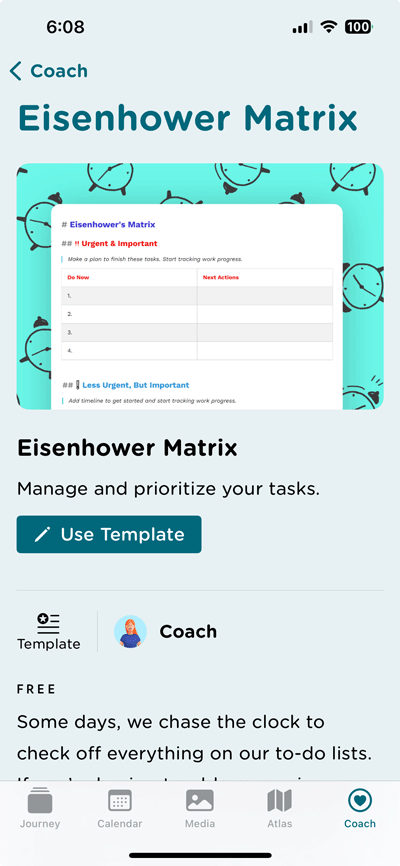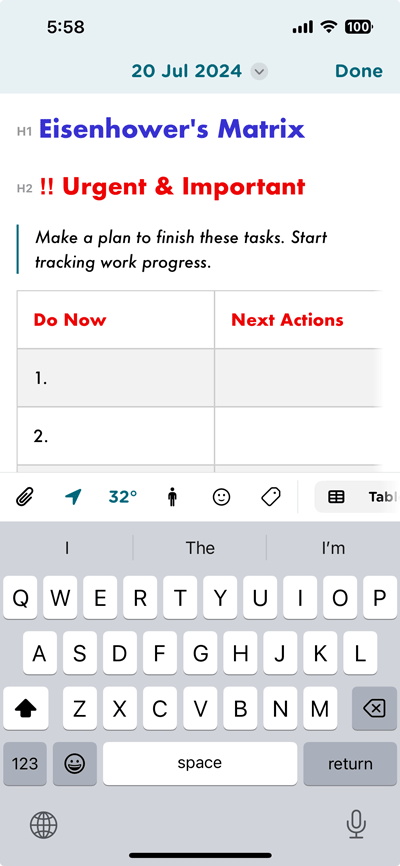How to Use the Eisenhower Matrix in Your Daily Journaling
Discover how you can use the Eisenhower Matrix in a journal to help you organize and manage your daily tasks. In this blog post, we guide you on how to integrate this powerful time management tool into your daily journaling routine. Boost your productivity and focus on what truly matters.

Maintaining organization and managing tasks effectively can be quite challenging. This is where the Eisenhower Matrix proves invaluable—a time management tool that prioritizes tasks according to urgency and importance. Integrating this matrix into your daily journaling routine can significantly boost your productivity and ensure your focus remains on what truly matters.
This blog post will guide you on how to incorporate the Eisenhower Matrix into your daily journaling routine, streamlining your tasks and enhancing your efficiency.
Understanding the Eisenhower Matrix
The Eisenhower Matrix, also known as the Urgent-Important Matrix, was popularized by former U.S. President Dwight D. Eisenhower. The matrix helps categorize tasks into four distinct quadrants based on urgency and importance:
- Quadrant I: Urgent and Important
- Quadrant II: Important but Not Urgent
- Quadrant III: Urgent but Not Important
- Quadrant IV: Neither Urgent nor Important
Tasks that need immediate attention. These are often crises or problems that require urgent resolution.
Tasks that are important for long-term goals but do not need immediate action. These include planning, strategizing, and personal development.
Tasks that require immediate attention but are not important. These often include interruptions, meetings, or activities not aligned with your main goals.
Tasks that are neither urgent nor important. These are typically distractions that do not contribute to your goals.
By understanding and using this matrix, you can efficiently prioritize your tasks and make better decisions about where to focus your energy.
Daily Journaling with the Eisenhower Matrix
Integrating the Eisenhower Matrix into your daily journaling routine can transform how you manage your tasks, making your workflow more structured and efficient. Here’s a step-by-step guide to maximize the effectiveness of this practice:
Step 1: List All Your Tasks for the Day
Begin your day by writing down everything you need to accomplish. This initial list should be comprehensive, detailing all tasks without concern for their importance or urgency. This brain dump allows you to clear your mind and ensures you won’t overlook any responsibilities.
Example:
October 1, 2024
• Respond to urgent client emails
• Schedule annual medical check-up
• Work on quarterly report
• Plan next week’s team meeting agenda
• Review and file invoices
• Exercise for 30 minutes
• Research industry trends
• Buy groceries
Step 2: Categorize Tasks into the Four Quadrants
Using the Eisenhower Matrix, evaluate each task and place it into one of the four quadrants:
Quadrant I: Urgent and Important
These tasks require immediate action and are crucial for your goals or deadlines. Speak to their high stakes.
- Respond to urgent client emails
- Work on quarterly report
Quadrant II: Not Urgent but Important
These tasks contribute to long-term success and personal growth, though they don’t require immediate attention. Prioritizing these can prevent future crises.
- Respond to urgent client emails
- Work on quarterly report
- Schedule annual medical check-up
- Plan next week’s team meeting agenda
- Exercise for 30 minutes
- Research industry trends
Quadrant III: Urgent but Not Important
These tasks demand immediate attention but are not crucial to achieving significant results. Often they can be delegated or managed with minimal effort.
- Respond to urgent client emails
- Work on quarterly report
- Schedule annual medical check-up
- Plan next week’s team meeting agenda
- Exercise for 30 minutes
- Research industry trends
- Review and file invoices
- Buy groceries
Quadrant IV: Not Urgent and Not Important
These tasks are neither time-sensitive nor critical. They can be minimized, outsourced, or even eliminated to focus on more impactful activities.
- Respond to urgent client emails
- Work on quarterly report
- Schedule annual medical check-up
- Plan next week’s team meeting agenda
- Exercise for 30 minutes
- Research industry trends
- Review and file invoices
- Buy groceries
- Social media scrolling
- Watching TV shows
Step 3: Allocate Time and Resources
Once tasks are categorized, create a schedule that designates specific times for addressing each quadrant’s tasks.
Morning: Quadrant I
Start your day by tackling the most urgent and important tasks. This period often aligns with peak productivity hours, allowing you to handle these critical tasks with fresh energy.
October 1, 2024
• 9:00 AM - 10:00 AM: Respond to urgent client emails
• 10:30 AM -12:00 PM: Work on quarterly report
Midday: Quadrant II
Reserve the late morning or early afternoon for important but non-urgent tasks. This strategy helps you invest in long-term goals and well-being before energy levels potentially wane.
October 1, 2024
• 1:00 PM - 1:30 PM: Schedule annual medical check-up
• 1:30 PM - 2:00 PM: Plan next week’s team meeting agenda
• 2:00 PM - 2:30 PM: Research industry trends
• 2:30 PM - 3:00 PM: Exercise for 30 minutes
Afternoon: Quadrant III
After completing the crucial tasks, manage the urgent but less important ones, potentially delegating some to others if possible.
October 1, 2024
• 3:00 PM - 3:30 PM: Review and file invoices
• 4:00 PM - 4:30 PM: Buy groceries
Evening/Leisure: Quadrant IV
Limit time spent on these activities or use them as a way to unwind after completing more demanding tasks.
October 1, 2024
• 7:00 PM onwards: Light entertainment or relaxation activities
Step 4: Review and Adjust as Necessary
At the end of the day, review your journal to assess what you’ve accomplished. Reflect on your productivity, and note any obstacles you encountered. This review will help you make informed adjustments for the following day.
Questions for Reflection:
- What did I complete? Review checked-off tasks and acknowledge your achievements.
- Which tasks remain? Identify tasks that weren’t completed.
- Why were tasks not completed? Determine if they were lower priority, if new urgencies arose, or if time management needs improvement.
- How can I improve? Adjust your task prioritization, allocate different time slots, or address distractions to enhance productivity.
This iterative process ensures continuous improvement and fine-tuning of your task management.
Example Review Entry:
• Completed: Respond to urgent client emails, Work on quarterly report, Plan next week’s team meeting agenda
• Pending: Research industry trends, Exercise for 30 minutes
• Reflection: Spent extra time on urgent client emails due to unexpected follow-ups. Will allocate more uninterrupted time for Quadrant II tasks tomorrow.
By repetitively using the Eisenhower Matrix in your daily journaling, you’ll develop an intuitive sense of prioritization that enhances your productivity and personal growth. This method fosters discipline and clarity, enabling you to focus on what truly matters and effectively manage your time and resources.
Setting Up the Eisenhower Matrix in Your Journey Journal
If you're excited about integrating the Eisenhower Matrix into your daily journaling practice, the first step is to gather the right tools. Journey offers an excellent digital platform that can suit your style and needs perfectly.
Selecting the Right Journal App

Journey offers a user-friendly interface coupled with robust features, making it effortless to organize and prioritize your tasks. Whether you're managing professional responsibilities or personal goals, Journey's customizable templates, including the Eisenhower Matrix, provide a structured approach to tackling your daily tasks. Its seamless integration of the matrix allows for easy categorization of tasks into the four quadrants, enabling you to focus on what truly matters. With Journey, you can enhance your productivity and maintain a balanced workflow, all within a single, intuitive platform.
Downloading a Template for the Eisenhower Matrix in Journey
In Journey, you have access to the Eisenhower Matrix journal template, available within the coaching program. You can easily download this template and start organizing your tasks effectively. The template includes all four quadrants of the Eisenhower Matrix, allowing you to prioritize your activities based on their urgency and importance.

Set Reminder to Manage Your Time
To get the most out of this setup, use Journey's reminder feature. You can set up reminders to alert you during the day about which quadrant you should focus on. This will help you stay on top of your priorities and manage your time well. With these features, Journey makes it simple to keep a balanced and productive schedule.
The Eisenhower Matrix is a powerful tool that can significantly enhance your daily journaling practice. By effectively prioritizing tasks, you're set to improve your productivity, reduce stress, and ensure a better work-life balance. Start incorporating the Eisenhower Matrix into your journal today, begin with small steps, and watch how it transforms your daily routine.


